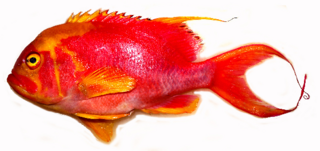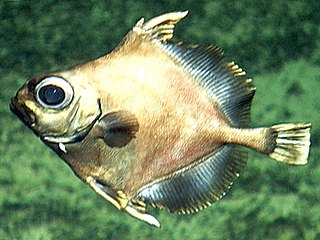Related Research Articles

Marine biology is the scientific study of the biology of marine life, organisms in the sea. Given that in biology many phyla, families and genera have some species that live in the sea and others that live on land, marine biology classifies species based on the environment rather than on taxonomy.

Acanthurus is a genus of fish in the family Acanthuridae found in the Atlantic, Indian and Pacific Ocean. They are found in tropical oceans, especially near coral reefs, with most species in the Indo-Pacific but a few are found in the Atlantic Ocean. As other members of the family, they have a pair of spines, one on either side of the base of the tail which are dangerously sharp.

Eugenie Clark, popularly known as The Shark Lady, was an American ichthyologist known for both her research on shark behavior and her study of fish in the order Tetraodontiformes. Clark was a pioneer in the field of scuba diving for research purposes. In addition to being regarded as an authority in marine biology, Clark was popularly recognized and used her fame to promote marine conservation.

Cirrhilabrus, the fairy wrasses, is a genus of fish in the family Labridae native to coral reefs and nearby habitats in the Indo-Pacific region. They are brightly colored and do not surpass 16 cm (6.3 in) in length. Males are larger and more colorful than females. They are commonly kept in aquaria.

Caranx lugubris, the black jack, black trevally, black kingfish, coal fish or black ulua, is a species of large ocean fish in the jack family Carangidae. The species has a circumtropical distribution, found in oceanic, offshore waters of the tropical zones of the Pacific, Atlantic and Indian Oceans. The species is particularly prevalent around offshore islands such as the Caribbean islands in the Atlantic, Hawaii and French Polynesia in the Pacific and the Seychelles and Maldives in the Indian Ocean. Black jack are rare in shallow waters, preferring deep reefs, ledges and seamounts in clear waters. The species is easily distinguished by its black to grey fins and jet black scutes, with the head having a steep profile near the snout. The largest recorded length is 1 m and weight of 17.9 kg. The black jack lives either individually or in small schools, and is known to school with other species. It is a predatory fish, taking a variety of fish, crustaceans and molluscs as prey. Sexual maturity is reached at 34.6 cm in females and 38.2 cm in males, with spawning taking place between February and September in the Caribbean. The early life history of the species is very poorly understood. Black jack are of high importance to many island fisheries, but are rarely encountered in most continental fisheries. The species has a reputation as a gamefish, and is variably considered a terrible or excellent food fish, although several cases of ciguatera poisoning have been attributed to the species. The species was initially named Caranx ascensionis by Georges Cuvier, however several issues with the use of this name have seen Felipe Poey's name Caranx lugubris become the valid scientific name.

Paracheilinus is a genus of flasher wrasses, native to the Indian Ocean and the western Pacific Ocean.

Pseudanthias bartlettorum, Bartlett's anthias is a species of marine ray-finned fish in the subfamily Anthiinae of the family Serranidae, the groupers and sea basses. It occurs in the Pacific Ocean. This fish is sometimes kept in aquaria.

The Carpenter's flasher wrasse, Paracheilinus carpenteri, is a species of wrasse native to the western Pacific Ocean. It can be found on reefs at depths from 27 to 45 m. This species can reach 8 cm (3.1 in) in standard length. It can be found in the aquarium trade.

The UPLB Limnological Research Station traces its root from the Department of Entomology, of the then UP College of Agriculture. Since its conception, the station contributed immensely to the understanding of the bounties of Laguna de Bay and helped establish the duck farming industry on Los Baňos foreshores and pioneered in aquarium fish production in the country. It serves as the base for studies on limnology and biology of aquatic organisms aimed at developing strategies for the optimum utilization and sustained production of aquatic resources; developing, adapting or improving conventional technologies used to increase fish production; and promoting environment friendly approaches for effective water management.

The gold-band fusilier also known as the yellow-band fusilier or black-tipped fusilier, is a species of marine ray-finned fish, a fusilier belonging to the family Caesionidae. It is widespread around reefs in the Indo-West Pacific region.
Meganthias carpenteri, the yellowtop jewelfish or Carpenter's yellowtop jewelfish, is a pink and yellow fish found in the eastern Atlantic Ocean named after Old Dominion University marine biologist Kent E. Carpenter. Meganthias carpenteri is a member of the subfamily Anthiinae which is classified under the family Serranidae which also includes the groupers and the serranine sea basses.
St. Andrews Biological Station is a Fisheries and Oceans Canada research centre located on Brandy Cove Road in St. Andrews, New Brunswick.
Seriola carpenteri is a species of bony fish commonly known as the Guinean amberjack, which feeds on squids and fishes. It attains a size of at least 48 cm fork length, and probably attains a much larger size. Adults are pelagic or epibenthic. Generally confined to areas where surface temperatures exceed 25 °C, the species is found in coastal waters over continental shelf from the surface to at least 200 m deep.
Anatoly Petrovich Andriyashev was a Soviet and Russian ichthyologist, marine biologist, and zoogeographist, notable for his studies of marine fauna of the Arctic and the Northern Pacific.

Angel Chua Alcala was a Filipino biologist who was named a National Scientist of the Philippines in 2014. Alcala is known for his fieldwork to build sanctuaries and to promote biodiversity in the aquatic ecosystems of the Philippines. He was the Chairman of the Board of Advisers at the Angelo King Center for Research and Environmental Management located in Silliman University. Alcala published more than 200 peer-reviewed articles and books and his biological contributions to the environment and ecosystems have made him a renowned figure of natural sciences in the Philippines.
John Ernest "Jack" Randall was an American ichthyologist and a leading authority on coral reef fishes. Randall described over 800 species and authored 11 books and over 900 scientific papers and popular articles. He spent most of his career working in Hawaii. He died in April 2020 at the age of 95.
Vema Seamount is a seamount in the South Atlantic Ocean. Discovered in 1959 by a ship with the same name, it lies 1,600 kilometres (1,000 mi) from Tristan da Cunha and 1,000 kilometres (620 mi) northwest of Cape Town. The seamount has a flat top at a mean depth of 73 metres which was eroded into the seamount at a time when sea levels were lower; the shallowest point lies at 26 metres depth. The seamount was formed between 15-11 million years ago, possibly by a hotspot.

Choranthias is a genus of marine ray-finned fish from the grouper and sea bass family Serranidae. It was created in 2012 and the name is a compound of the Greek chora meaning "room" or "space" and anthias meaning a "seafish", a reference to the broken lateral line of this genus compared to the other genera classified within the subfamily Anthiinae.

Meganthias is a genus of marine ray-finned fish from the subfamily Anthiinae, part of the family Serranidae, the groupers and sea basses. They are found in the Indo-Pacific region and the eastern Atlantic Ocean.

The false boarfish is a species of fish in the family Oreosomatidae (oreos).
References
- ↑ Old Dominion University, Norfolk, Virginia, Department of Biological Sciences: Dr. Kent E. Carpenter Professor of Biological Sciences, "The Department of Biological Sciences". Archived from the original on 2011-01-02. Retrieved 2011-01-02., Updated: 04/17/07.
- ↑ John E. Randall and Roger Lubbock. 1981. Labrid Fishes of the Genus Paracheilinus, with Descriptions of Three New Species from the Philippines. Japanese Journal of Ichthyology 28(1): pages 19-30 + 2 col. pl.
- ↑ W. D. Anderson, Jr. 2006. Meganthias carpenteri, new species of fish from the Eastern Atlantic Ocean, with a key to eastern Atlantic Anthiinae (Perciformes: Serranidae). Proceedings of the Biological Society of Washington 119(3): pages 404-417.
- ↑ Phyllis Brown (ed.). 2007. New Fish Species Named for Biologist Carpenter. Scire, Old Dominion University College of Sciences Newsletter, Edition 30, February 20, 2007, http://sci.odu.edu/sci/Scire/30edition/faculty/NewFish.html Archived 2011-07-20 at the Wayback Machine , n.p.
- ↑ Phyllis Brown, ed. (2007). "New Fish Species Named for Biologist Carpenter". Scire, the Old Dominion University College of Sciences Newsletter. Old Dominion University. Archived from the original on 2011-07-20.